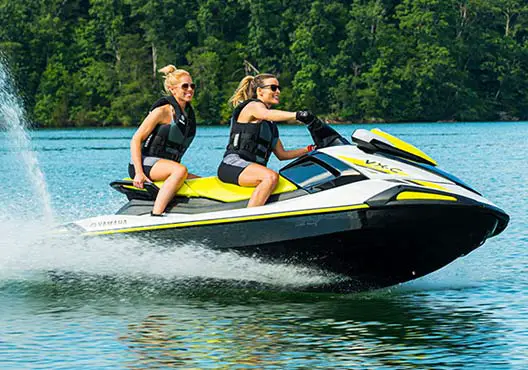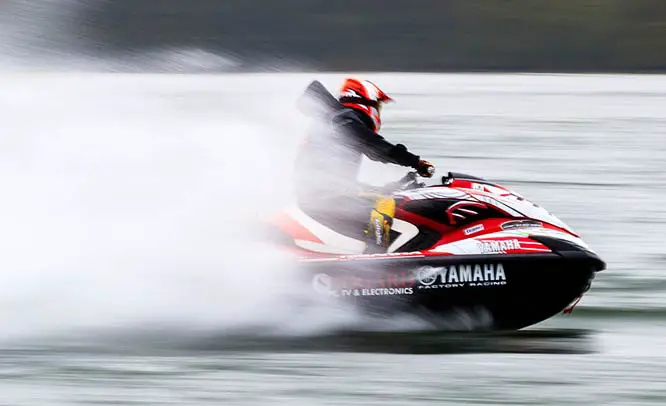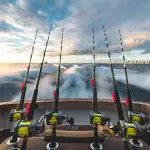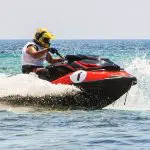Long-time watercraft enthusiasts and newcomers alike might understandably be a bit puzzled when considering whether to buy a new or previously owned recent Yamaha FX or VX Waverunner.
Yamaha’s VX series was originally introduced in 2004 as a less expensive alternative to the company’s flagship FX line, but has since grown in comfort and performance to the point that it now rivals its more expensive older brother.
To understand how their paths converged, we have to take a look at where each came from.
Contents
A bit of Waverunner history
Yamaha’s flagship FX lineup ushered in the four-stroke personal watercraft era way back in 2002 with the FX140. Based in part on the legendary two-stroke 155-horsepower GP1200 musclecraft, the FX line slightly softened the more aggressive aspects of the GP’s race-oriented hull and coupled it with a smooth, quiet, and smokeless powerplant to produce a PWC that would in part change the sport forever.
The FX has of course been substantially improved and refined in its 20-year life, with major upgrades occurring in 2009, 2012, and 2019. Subtle yet substantial improvements were made again this year for the 2022 models.
More power
A high output model was released just two years after the FX’s debut, but both engine size and power output saw exponential gains in 2009, when a 1812cc powerplant – supercharged at the top of the lineup – replaced the original 998cc four-cylinder engine.
The new motor not only bumped horsepower from 160 to a very conservatively rated 180-hp output (normally aspirated), it weighed 30 pounds less than its predecessor despite being nearly double the displacement.
A revised larger hull
The next big revision came in 2012. Yamaha left the powerplant largely unchanged, but an all-new hull grew 7.5 inches in length as the watercraft grew in both size and comfort.
Most felt the larger hull, which also featured subtle redesigns in chine positioning and length, gave the already stable craft an even more secure handling package.
Much more power!
In 2014, the motor package would be upgraded as well with the then all-new Super Vortex High Output marine engine.
Yamaha shied from releasing horsepower numbers in those years, but it was widely believed that the addition of a new supercharger, a 25 percent more efficient intercooler, and more conventional improvements like larger fuel injectors and lighter forged pistons bumped the FX’s output to well over 260 ponies.
More comfort, more amenities
Yet another all-new hull would debut in 2019, again advancing stability, predictability, and comfort in choppy water conditions.
By this time, the bells and whistles had also expanded at an exponential rate, with the FX Cruiser SVHO introducing the first color touchscreen instrumentation.
In the current FX lineup, SVHO models are powered by Yamaha’s supercharged 1.8L marine engine, with the HO models powered by Yamaha’s 1.8L normally-aspirated motor.
This year’s big news
For 2022, the FX has received invisible yet substantial updates once again.
Heading the changes is a change to a thicker heavy duty SMC fiberglass hull. This promises to deliver more comfort in choppy and rough conditions.
Other changes include a new ride plate and repositioned sponsors, which have been relocated slightly farther forward in an effort to bring the nose of the craft higher out of the water.
The ride plate has been angled up 3 degrees. Both changes are aimed at raising the bow of the craft when underway, reducing both drag and bow spray.
Yamaha’s proprietary Nanocomposite hull material now features into the top deck only, with the under hull now being all SMC fiberglass construction. SMC is heavier, but also far easier to repair.
More importantly, with the traditional fiberglass construction, there is less flexing and cracking than with the composite. The new hull promises even greater comfort along with durability, especially in choppy waters.
The Waverunner VX: From entry level to upper shelf
When Yamaha originally introduced the VX lineup, it was aimed at the entry-level buyer at a price point thousands of dollars below the FX line.

We named it the 2005 Watercraft of the Year at Watercraft World at the Elhert Award ceremonies some months later as the VX introduced legions of new riders to the sport. Sales continued to be strong for the entry-level model.
Power changes everything
In 2011 the lines began to blur between the FX and VX line when Yamaha chose to add the FX’s 1.8L motor into the lightweight VX hull platform. Suddenly, a machine that sold in the very low five figure range was capable of near as top-shelf performance. The top speed of the VXS model that year jumped to 67 mph.
With the bigger motor but the craft still weighing in at just 721 pounds – as opposed to the FX’s 800-pound plus heft – the VXS felt like a still lighter machine from the two-stroke past. For a PWC offering the capacity to carry two passengers in addition to its operator, the VXS responsiveness was light and playful like few other machines then currently available.
Yamaha did continue to sell a base model VX well below the five-figure price tag threshold that continued to use the company’s venerable 1052cc fuel injected four-cylinder engine.
The VX line also notably continued with a minimal level of basic equipment as Yamaha’s baseline ski, relying on absolute basics to both control pricing and extol the virtues of the absolute basics that make watercraft so fun to ride.
The evolution truly begins
The hull design was tweaked in 2015 with a new keel and softer chines towards the bow. Now, the VX was moving towards the versatility of its more expensive sibling.
Stability was enhanced at lower speeds, the boat tracked truer when used as a tow vehicle for skiers, and its capabilities in rougher conditions improved.
The next model year saw the venerable 1,052cc MR-1 powerplant that formerly sat below the seat replaced with a lighter and more compact 1,049cc TR-1 HO engine that bumped horsepower 13 ponies higher.
The VX gets promoted
In 2017 the VX edged ever closer into FX territory with the introduction of the Cruiser model. The obvious change was a seat designed for long-term comfort.
But the big news that year was the introduction of an all-new line of EX models that supplanted the FX lineup from the entry-level tier. The lower price point of the EX machines freed up designers to begin adding benefits and features to the VX series.
The seat added to the Cruiser HO model was a tiered theater-style design for improved passenger comfort and sightlines while also improving lower-back support and security. Amenities improved with larger storage compartments. Cup-holders became standard. More significantly, so did cruise control and a no-wake mode. And it was still priced around $5000 below the FX lineup.
Bring in the bells and whistles
The VX line again received a substantial makeover for the 2019 model year with a wide array of new features and another not-so-subtle hull revision with changes in stern and bow corners pushing the watercraft towards a slightly more aggressive handling package.
Footwells were deepened and widened, and the seat became 1.5 inches more narrow allowing riders to use their legs more in corners and to take the strain off their backs in straight line runs through rough waters.
In the amenities department, the twin factory installed speakers paired with a two-channel 50-watt amplifier migrated over from the FX line, along with a new 4.3-inch multi-function LCD control screen.
In addition to the necessary information like speed, rpm, and fuel level, the system also shows real-time fuel consumption and allows its rider to set acceleration profiles, a governed top speed for younger or less experienced riders, and a four-digit pin code to prevent anyone from taking a ride without permission.
So which should you buy today?
It’s a tough call, honestly. Your mileage may vary, and there simply isn’t any clear consensus among owners and riders who’ve ridden both. There is, however, the matter of bang for the buck.
Yamaha’s FX line is the pinnacle of engineering from the company that literally invented the sit-down watercraft design that now dominates the market. The FX offers complete predictability and comfort when navigating rough waters. It is extremely stable and an excellent choice for offshore conditions, while still retaining a large degree of responsiveness. It’s fast, comfortable, and will still cut a rug in a tight corner. If comfort is a greater concern than cost, you won’t go wrong by digging deep for an FX.
But then, there’s ample reason the VX Cruiser HO has held fast as the best-selling personal watercraft in the industry for three years running. By virtue of its lighter weight, it offers about 95 percent of the straight line performance as the heavier FX. The VX is plenty stable enough for a first-timer to feel totally comfortable, and also capable of satisfying far more aggressive performance-oriented riders. And it is still as comfortable to spend a day on as virtually any other ski on the market.
One clear caveat with the VX is that the non-HO models remain a good bit more entry level in terms of power delivery. When riding two-or three-up, or when pulling tubes or skiers, the lower power output of the TR-1 three cylinder – rated at 125 horsepower – is revealed. The HO engine, at 180 horses, is what propels the VX into FX territory.
The people’s choice
Though the VX line was originally introduced as a highly affordable four-stroke personal watercraft in the fledgling days of the shift from two-stroke to four-stroke machines, the craft became more and more popular as years passed and amenities, handling, and power delivery all rose to the occasion.
All in all, the VX lineup has led the sales charts more often than not for almost two decades. Surely so many happy owners couldn’t be wrong?






